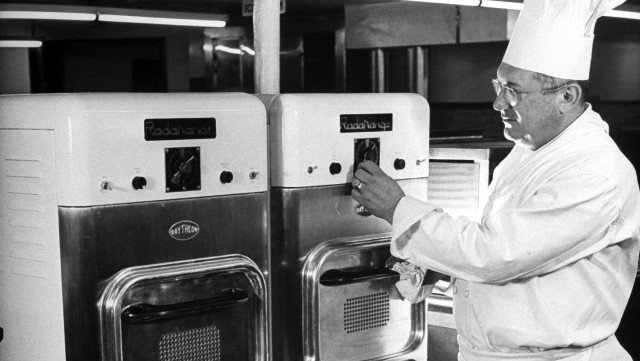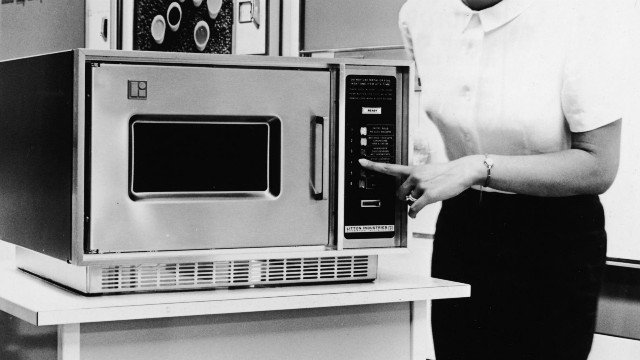Quick Fact: How Microwave Cooking Works
Although cooking in the microwave oven is similar to cooking in conventional oven, microwaves penetrate food much faster and deeper. They do not cook the food from the inside (common misconception), neither do they cook it directly. What they do is affecting the water molecules from within with little effect on other molecules like protein, fat, carbohydrates, etc. The microwave radiation penetrates the food evenly throughout, and heats up the water which then cooks the food. Because some food contains more water inside than outside (pastry or pies with filling, potatoes, etc.), it can give an impression that it starts cooking the food from within its centre. When a product contains evenly spread amount of water, the water on the surface is cooked first as it swallows up the most of the microwaves. That's why it is difficult to use microwave oven for cooking the food that contains little amount of water like dry food. Because the water boils at 100°C (usually), the temperature never gets beyond that point. The conventional oven requires much higher temperature over 200°C that breaks down sugars and proteins giving the food its specific crust.
The microwaves are part of the spectrum of electromagnetic radiation that has wavelengths shorter than radio waves but longer than infrared light. The first microwave oven was invented by American physicist Percy Spencer. While experimenting with microwave magnetron (high density electromagnetic field generator) that was designed for use in military radars, he discovered that the candy bar in his pocket had melted. He later experimented with various sorts of food including popcorn (first microwave popcorn) or egg (which exploded in the face of his co-worker). In 1945, he patented the first, safe for use, microwave oven called Radarange that included magnetron which emitted microwaves into an enclosed metal box. Two years later, in 1947, the first commercial microwave oven was manufactured.

[Some of the first commercial Radarange. Picture Source]
References:
"Microwave Oven", Wikipedia article.
"Percy Spencer", Wikipedia article.
"Microwave", Wikipedia article.
-logic
If you like this article, please follow my blog on Steemit
You can also find me on Twitter


Thank you, that was informative.
Thanks too.
Thanks so much for this wonderful article. I always wanted to more about the history and specifics behind microwave technology. It also now makes sense why it's rather difficult to make food crispy when using a microwave compared to an oven since the temperature doesn't go above boiling temperature for water.
You are welcome. Thanks for commenting.
Thanks for sharing .
we can mutually benefit following & upvoting each others post.
my blogs are related to Yoga ,Ayurveda ,Personal dev,The3 things & crypto.I am sure you will like them.
have upvoted above post .
waiting for you coming to my Small home of wellness .
Very interesting! I'm a Chef and nowadays, many of my collegues use mircrowaves for, well, everything, without knowing what to consider. I will follow your account!
Microwaves are generally not welcome in restaurant's kitchen by any credible chef and should not be :-) Thanks for the comment
Always wanted to know the specifics and history of how a microwave works, thanks!!
Too much water in the tomato sauce for the microwave oven? ;)
Yeah, That's why liquids must be covered in microwave, with slight gap for steam. As you know :-)
For example, eggs explode because water boils and rapidly evaporates inside. As you know too :-)
Btw I just got comment invitation to join SteemSTEM lol
I guess auto invite.
Anyway, I decided to post short articles with less sources and facts (which is not very good) as long as I receive small rewards? No point spending whole day writing to get 10sbd
This would mean potential small rewards, indeed ;)
I added SteemSTEM tag then. I just was not sure before if quality of article was enough for it. You guys post really well written and comprehensive articles.
Thanks for the nice words :)
Join us on #steemSTEM
Thank you for this very interesting article. It has been advertised on our chat channel (and upvoted).
The steemSTEM project is a community-supported project aiming to increase the quality and the visibility of STEM (STEM is the acronym for Science, Technology, Engineering and Mathematics) articles on Steemit.
Nice article :)
Thank you for sharing with us how the microwave works. I didn't know it focused on water molecules in the food. Well, they say u learn something new each day. :)
Thank you for reading. I learn myself as I research new material for the posts.